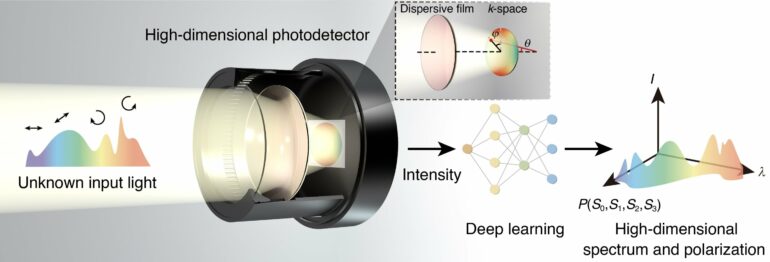A new study published in Nature, conducted by an international collaboration team led by Prof. Wei Li from the Changchun Institute of Optics, Fine Mechanics and Physics (CIOMP) of the Chinese Academy of Sciences, introduces a novel miniaturized photodetector capable of characterizing arbitrary polarization states across a broadband spectrum with a single device and a single measurement.
“Traditional photodetectors are limited to measuring light intensity alone. Existing polarization and spectrum photodetectors often rely on the complex integration of multiple polarization- or wavelength-sensitive elements in time or space to enhance detection capabilities,” said Professor Wei Li.
“Current photodetectors typically sacrifice one dimension of information for another; they can measure either intensity and polarization at a fixed wavelength or intensity and wavelength under uniform polarization.
“This limitation means that existing methods can only detect light fields with predetermined polarization or wavelength values projected onto a three-dimensional parameter space, thereby losing degrees of freedom needed for many natural scenarios where light may carry arbitrary changes in polarization and intensity across a broad spectrum,” said Professor Cheng-Wei Qiu from the National University of Singapore.
The team leveraged spatial dispersion on a frequency-dispersion interface to modulate converging light fields with wavevector-dependent responses across different azimuthal and incident angle channels. They initially discovered that, according to Fresnel’s formula, even the simplest dispersive interfaces exhibit specific polarization and wavelength responses under oblique incidence, which can be further enhanced by resonance.
Based on this, through a uniform dispersion film, the interfaces can map light from all channels carrying rich polarization and spectrum information in a single imaging, aided by deep residual networks for decoding high-dimensional polarization and spectrum information.
“Our photodetector is capable of demonstrating high spectral resolution and accurate reconstruction of full-Stokes polarization states in both theoretical and experimental settings. Precision detection of high-dimensional information by our photodetector, such as a two-color laser field with different polarization states or broadband reflection from a gold interface exhibiting varying polarization states, is achieved beyond the capabilities of commercial polarimeter and spectrometer.
“Additionally, this approach can be extended to imaging applications by sandwiching the film with a commercial microlens array and sensor array to realize ultra-compact high-dimensional imager,” said Assistant Professor Chunqi Jin from the Changchun Institute of Optics, Fine Mechanics and Physics (CIOMP) of the Chinese Academy of Sciences.
Looking ahead, Prof. Wei Li envisions that ultra-broadband detection can be achieved by integrating broadband commercial photodetectors; the detection resolution can be further improved by using photonic crystals, metasurfaces, and two-dimensional materials instead of existing thin film schemes; and the detection capability can be stepped up in higher dimensions by integrating functionalities such as image processing, and distance measurement.
In addition, combining physical models with deep learning models can enhance deciphering capability and reduce the amount of the priori resources required.
In conclusion, this approach promises to redefine the landscape of high-dimensional photodetection and imaging technologies, marking a significant milestone in light characterization. Its anticipated transformative applications span across diverse fields, signaling a promising future for advancements in light-based technologies.
More information:
Yandong Fan et al, Dispersion-assisted high-dimensional photodetector, Nature (2024). DOI: 10.1038/s41586-024-07398-w
Citation:
Researchers create dispersion-assisted photodetector to decipher high-dimensional light (2024, May 27)



